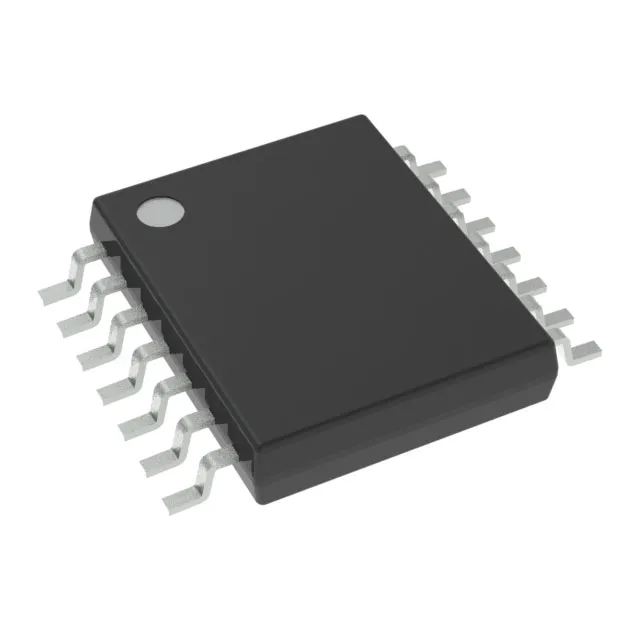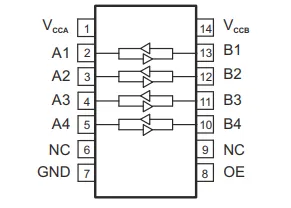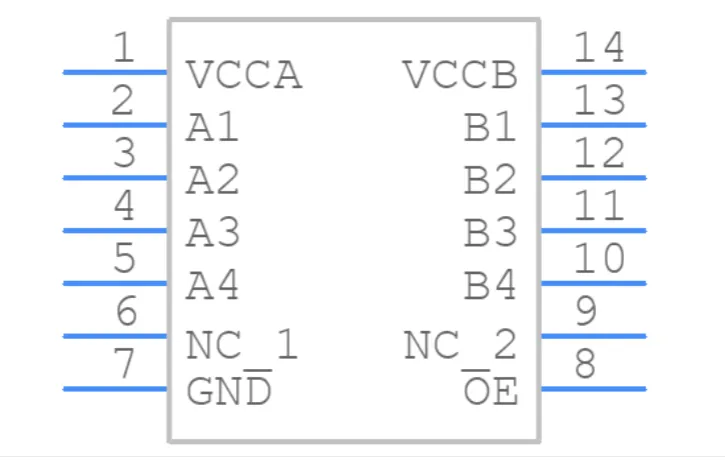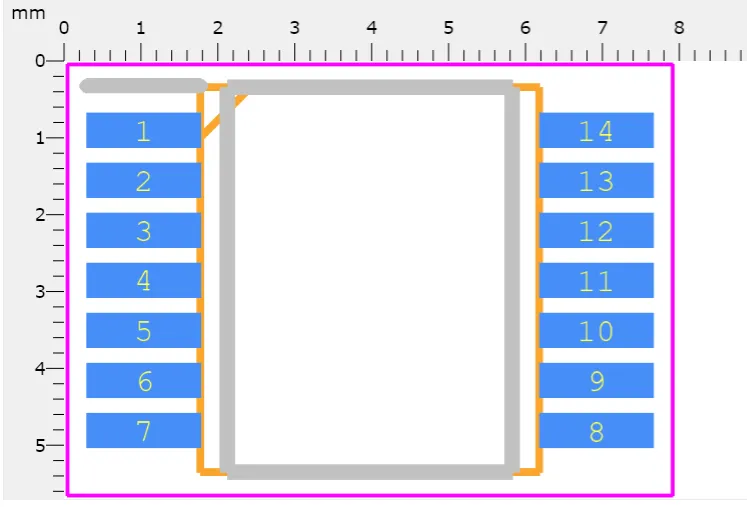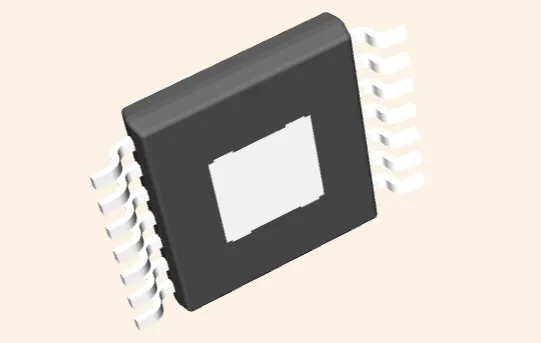TXB0104PWR Review: Overview, Features, and Applications
TXB0104PWR
Product Overview
Part Number: TXB0104PWR
Manufacturer: Texas Instruments
Description: Translation - Voltage Levels 4-Bit Bi-directional V-Level Translator
Lead Time: Can Ship Immediately
Datasheet: Datasheet PDF
Category: Translator
Number of Pins: 14
Short Description
Voltage Translators & Level Shifters 14 pins Tape & Reel (TR) for 1 Voltage Level 14-TSSOP (0.173, 4.40mm Wide) Active 6 Weeks Weeks 1 (Unlimited). There are two independent and programmable power supply rails connected in this 4-bit, non inverting translator (TXB0104).
Using two independently programmable power supply rails, the TXB0104 provides four-bit noninverting translation. A port is designed to track VCCA. It is acceptable for VCCA to accept any supply voltage within the range of 1.2 V and 3.6 V. It is designed to be used in conjunction with the A port when tracking VCCB. There are a wide range of voltages which can be used with the VCCB, ranging from 1.65 V to 5.5 V. By doing this, a low voltage 1.2 V, 1.5 V, 1.8 V, 2.5 V, 3.3 V, and 5-V voltage node can be converted bidirectionally between any of these voltages in a universal low voltage manner.
There is no way that VCCA can exceed the VCCB. There are no high-impedance outputs on the OE when the OE input is low, so all of the outputs are in high-impedance states. In order for OE to maintain its high-impedance state, it is necessary to connect it to GND via a pulldown resistor when the device is powered up or down. Depending on the power sourcing capacity of the driver, the minimum resistor value will be established.
TXB0104PWR Design
TXB0104PWR Pinout
TXB0104PWR Symbol
TXB0104PWR Footprint
TXB0104PWR 3D Model
TXB0104PWR Product Specifications
It is the responsibility of the respective owners of all trademarks, brands, and logos that appear on this site. The depiction, description, or sale of products featuring any of these brands, trademarks, or logos is not intended to imply affiliation or authorization.
-
Translator Type: Voltage Level
-
Channel Type: Bidirectional
-
Circuits : 1
-
Channels per Circuit: 4
-
Voltage - VCCA: 1.2 V to 3.6 V
-
Voltage - VCCB: 1.65 V to 5.5 V
-
Output Type: Tri-State, Non-Inverted
-
Data Rate: 100 Mbps
-
Temperature range: -40°C to 85°C (TA)
-
Features: Auto-Direction Sensing
-
Type of Mounting : Surface Mount
-
The package : 14-TSSOP (0.173", 4.40mm Width)
-
Base Number: TXB010
TXB0104PWR Features
An IC manufactured by Texas Instruments, the TXB0104PWR, performs voltage-level translation. The TXB0104PWR component has the following key features:
-
Bidirectional Voltage Translation: Various voltage levels can be communicated with the TXB0104PWR through bidirectional voltage translation.
-
Voltage Range: On both sides, the device works with voltage levels between 1.2V and 3.6V.
-
Auto Direction Sensing: Data flows are automatically sensed using auto-direction sensing, so no direction control signal is necessary since the device determines the direction of data flow.
-
4-Bit Level Shifter: A 4-bit level shifter, the TXB0104PWR translates four data lines between the high-voltage (B side) and low-voltage (A side).
-
High-Speed Operation: Designed to operate at high speeds, it is suitable for applications that require rapid data transmissions.
-
Low Power Consumption: Battery-operated devices and power-sensitive applications will benefit from the component's low-power design.
-
Latch-Up Performance: A robust operation in a variety of operating conditions is assured due to its good latch-up performance.
-
Open-Drain I/O Ports: Both the A and B sides of the TXB0104PWR offer open-drain I/O ports, allowing various devices to be interfaced.
-
Schmitt-Trigger Inputs: Hysteresis and noise immunity are provided by Schmitt-trigger inputs in this device.
-
ESD Protection: A typical device is protected from electrostatic discharge by electrostatic discharge protection (ESD).
-
Small Package Options: A small package option is available for the TXB0104PWR, making it suitable for applications that have limited space.
-
Applications: Various bidirectional communication buses, including I2C and SMBus, make use of level shifting, where two sections of the system operate at different voltages.
-
Compliance: Standards and specifications related to the component may allow the component to work with different systems while maintaining interoperability.
Applications of TXB0104PWR
An IC produced by Texas Instruments, the TXB0104PWR is a bidirectional voltage-level translator with a 4-bit resolution. Different voltage levels can be communicated with each other using this method. The TXB0104PWR can be used for the following applications:
Microcontrollers that interface with mixed voltages:
Embedded systems often require communication between microcontrollers operating at different voltage levels. Using TXB0104PWR facilitates the integration of these microcontrollers, resulting in smooth communication.
System Block Communication:
A complex electronic system may contain different voltage levels for different blocks or subsystems. This TXB0104PWR ensures that the proper data exchange is accomplished between these blocks.
Automotive Electronics:
There is often a wide range of voltage specifications in automotive systems. A TXB0104PWR can be utilized to translate voltages between different modules and communicate with them in automotive electronics.
Bus Extender for Remote Devices:
In a system, the TXB0104PWR facilitates reliable data transfer over longer distances using I2C or other communication buses.
Data Converters Interface:
To avoid signal degradation, ADCs and microcontrollers are tightly coupled with TXB0104PWR's voltage levels.
Customized Mixed-Voltage Systems:
When bidirectional voltage translation is required for a specific component in customized mixed-voltage systems, engineers and designers can utilize the TXB0104PWR.
Customized Mixed-Voltage Systems:
Various mixed-voltage systems can be designed and implemented using the TXB0104PWR, including bidirectional voltage translation.
I2C/TWI Bus Communication:
There are often TXB0104PWRs used to bridge the gap between two-wire interfaces and I2C (Inter-Integrated Circuit) busses. This ensures seamless communication between components at different voltage levels due to its bidirectional voltage translation.
Sensor Network Level Shift:
The TXB0104PWR allows the integration of sensors with different voltage requirements. Sensors communicate with microcontrollers and processors at different voltage levels, making this popular in applications with sensors.
Battery-Powered Devices:
Different voltage supplies are often used in portable electronic devices. Designed for battery-powered devices such as smartphones, tablets, and wearable electronics, the TXB0104PWR provides communication between these components.
Industrial Control Systems:
A TXB0104PWR can be used to facilitate communication and coordination among components in industrial automation and control systems operating at different voltage levels.
UART/Serial Communication:
When devices with different voltage levels need to communicate with each other, the TXB0104PWR can be used as a UART (Universal Asynchronous Receiver-Transmitter).
Detailed guidelines are provided by Texas Instruments in their datasheets and application notes. When using the TXB0104PWR in a variety of applications, the recommended operating conditions should be followed by everyone.
Similar Specs Components
Here in this section, we compared the different components which have the similar species with the TXB0104PWR component. Moreover, if you think we miss any important point, then make sure to let us know in the comment section.
Faqs
Question 1: How to connect the TXB0104PWR in my circuit?
Answer: Powering the IC requires connecting VCCA and VCCB voltages. Your circuit's voltage level on VCCA should match that on VCCB, while your circuit's voltage level on VCCA should match that of the lower-voltage side. Your devices' I/O pins should be connected to the TXB0104PWR's translation channels (such as A1, A2, B1, B2). Follow the recommended connections and guidelines in the datasheet and refer to the datasheet for more information.
Question 2: Does the TXB0104PWR support auto-direction sensing?
Answer: A direction signal is not necessary with the TXB0104PWR since it features auto-direction sensing. Data flow direction is automatically detected.
Question 3: Why is voltage translated in a bidirectional manner?
Answer: A bidirectional voltage translator lets devices on either side of the signal communicate with each other by translating voltage levels in both directions.
Question 4: How should the TXB0104PWR be used?
Answer: The datasheet provides guidelines on proper layout practices and recommended operating conditions in order to ensure the best possible performance.
Final Thoughts
The TXB0104PWR voltage translator operates seamlessly at a variety of voltage levels with its versatile, reliable 4-bit bidirectional design. In addition to its broad voltage range and auto-direction sensing features, it is highly recommended for a variety of applications due to its high speed and auto-direction sensing capabilities.
The datasheet guidelines must be followed carefully, recommended operating conditions need to be considered, and equipment must be positioned properly. Providing seamless communication across diverse voltage domains, the TXB0104PWR is an essential component of mixed-voltage system integration, serving as a robust solution for bidirectional voltage translation.
Capacitive Voltage Divider : Prinple & Its Applications
Voltage Amplifier vs Power Amplifier: What’s the Differences?
Comparison: LM2576 vs. LM2596 Voltage Regulators
Operation & Fault Handling of High Voltage Switchgear Explained
L7805ABV Voltage Regulator: Overview, Features, and Applications
How Does a Voltage Regulator Work? [Completely Explained]
Multimeter Not Reading DC Voltage: How to Fix it?
Does a Resistor Reduce Voltage
Multimeter Not Reading Current [How to Fix]
What is an Air Core Inductor? [Everything Explained]






